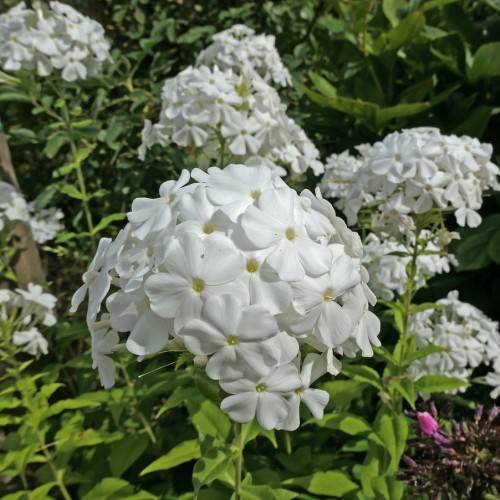
garden phlox
Phlox paniculata f. alba
Also Known As - border phlox,common phlox,common phloxCycle:
Herbaceous Perennial
Watering:
Average
Hardiness Zone:
4 - 8
Flowers:
Flowers In Summer
Sun:
Full sun, Part sun/part shade
Soil:
Rocky , gravelly , dry, Well-drained
Fruits:
Fruits In Autumn Ready In
Leaf:
Yes
Growth Rate:
High
Maintenance:
Moderate
Care Level:
Medium
watering
Garden phlox (Phlox paniculata f. alba) should be lightly watered as needed for the soil to remain evenly moist. This usually happens about every few days during the growing season, although exact frequency may depend on the temperature, humidity, and soil type. During periods of heavy rainfall, you may not have to water at all. Water the soil at the base of the plant, avoiding wetting the foliage and flowers. Mulch around the plant to help conserve soil moisture and keep the roots cool.
sunlight
Garden phlox (Phlox paniculata f. alba) needs at least 6 hours of direct sunlight per day, although it can tolerate some light shade. Full sun is best for flowers that are more vibrant and larger than those grown in shade. Sunlight is also needed for the development of the foliage. Inadequate sunlight can cause the foliage to become spindly and produce fewer flowers. Additionally, direct sunlight will help discourage disease and pests, keeping the flowers looking their best throughout the growing season.
pruning
Garden phlox (Phlox paniculata f. alba) should be pruned in late spring, as soon as it finishes blooming. Before pruning, remove any flowers that are dead. Then, reduce the length of the flowering stems by 2-thirds and cut them back to where new buds are visible. This will encourage the plant to produce more flowers. Additionally, trim any basal shoots (the growth from the base of the plant) that are longer than 6 inches. This will encourage healthy, compact new growth. Finally, make sure to remove any dead or diseased stems or leaves and discard away from the plant.
